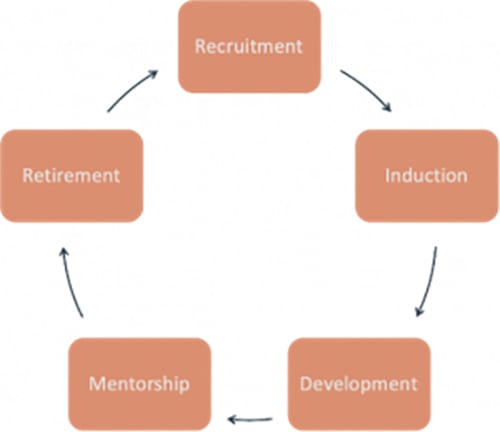A life cycle is a series of events bringing something new into existence, whether that’s a life, a product, or a director. The life cycle follows its growth and progression into maturity, eventual critical mass and finally, its decline.
The stages of the Director’s lifecycle are recruitment, induction, development, mentorship, and retirement. These stages encompass the progression a director goes through over their tenure with a Board and whilst there are some common factors, the length of each stage is unique for every Board and Director.
Let’s break down each stage:

Recruitment
The first step of any life cycle is important, because without the right foundation being built at the beginning, you’re setting yourself up for failure. Therefore, having the right people on your Board is key to being able to achieve your purpose. Choosing the right Directors is hard, it’s a balancing act between choosing between the people you have apply and the skills, experience, qualifications, and behaviours you need to fill from the Directors departing. Knowing how these potential Directors are going to complement the existing ones, (or perhaps not), is critical to ensuring that the right people are recruited.
Induction
44% of Directors (from our governance data insights) are not confident their induction process effectively prepares new Directors for their role on the Board. This is not a comforting statistic for any new Directors who might be looking to join a Board. Having spoken to Directors old and new about what their induction programs looked like, and what works and what doesn’t, we’ve found that having an individually, targeted approach is key. It’s not a good use of time and resources to be educating new Directors on something they are already experts in, nor is it wise to assume that a director already knows something, especially when it is sector related. Connecting a directors induction program to their skills and capabilities is proving to help fast track a director’s confidence, engagement, and satisfaction.
Development
We’ve spoken about it at length in previous blog posts, such as Board Skill Sets - New Requirements for a New World , in this new world we find ourselves in when it comes to the skills required on a Board. With this in mind, it’s more important than ever that we’re not only upskilling Directors in the areas that they need, but also in a way that ensures the Board is well rounded. A well-rounded Board has a combination of Sector Specific Skills, Professional skills, Contemporary skills and, of course, Behavioural Skills. Knowing where each Directors areas are for opportunities of development is key for a sensible development plan rather than a scattered, generic approach. Targeted Education relevant to the identified capability gaps is proving to be far more important than the old “one size fits all” Governance Education that used to be rolled out regardless.
Mentorship
Whilst this may not be a stage that every Director goes through or spends much time in, it is a vital step to ensure the continuation of their organisational knowledge. Where possible, it is essential that more tenured Directors take newer Directors under their wing. Even something as simple as offering to have a cup of tea pre and post a Board Meeting to go over any items that they may want clarification on, helps build their understanding and confidence and ultimately helps meetings run smoother. What can then also be gained, is that they both bring forward something to the other, the more tenured Directors offer Board experience and knowledge, and the newer Directors can remotivate and remind those older directors who might be feeling stagnant or stuck in their Board roles. It reignites the question – Why are you on the Board? – What is my “Why”? because they have someone asking.
Retirement
And finally, after the Director has served their term and is ready for their next step, it’s time to consider their retirement. However, how is a director supposed to be assured that all their hard work will be continued when 54% of Directors (from our Governance Data Insights) are not confident that their Board adequately addresses succession planning. The fundamental piece to understand here is what skills are about to leave the Board, so that you can look for someone with similar skills to replace those gaps. Or it can be used as an opportunity to broaden the skills on the Board and diversify those around the table.
As we’ve outlined in the life cycle progression above, being a director is a varied position that has five unique stages, each of which have specific requirements.
Thankfully, there is also the help of Boardroom Plus to assist with each stage of this life cycle as well. The Individual Director Development program that is now available – it helps people who want to be Directors become more prepared and the Whole Board Governance program that includes features to help with induction, development, recruitment, mentorship, and retirement.
Book into a demonstration below
Boardroom Plus